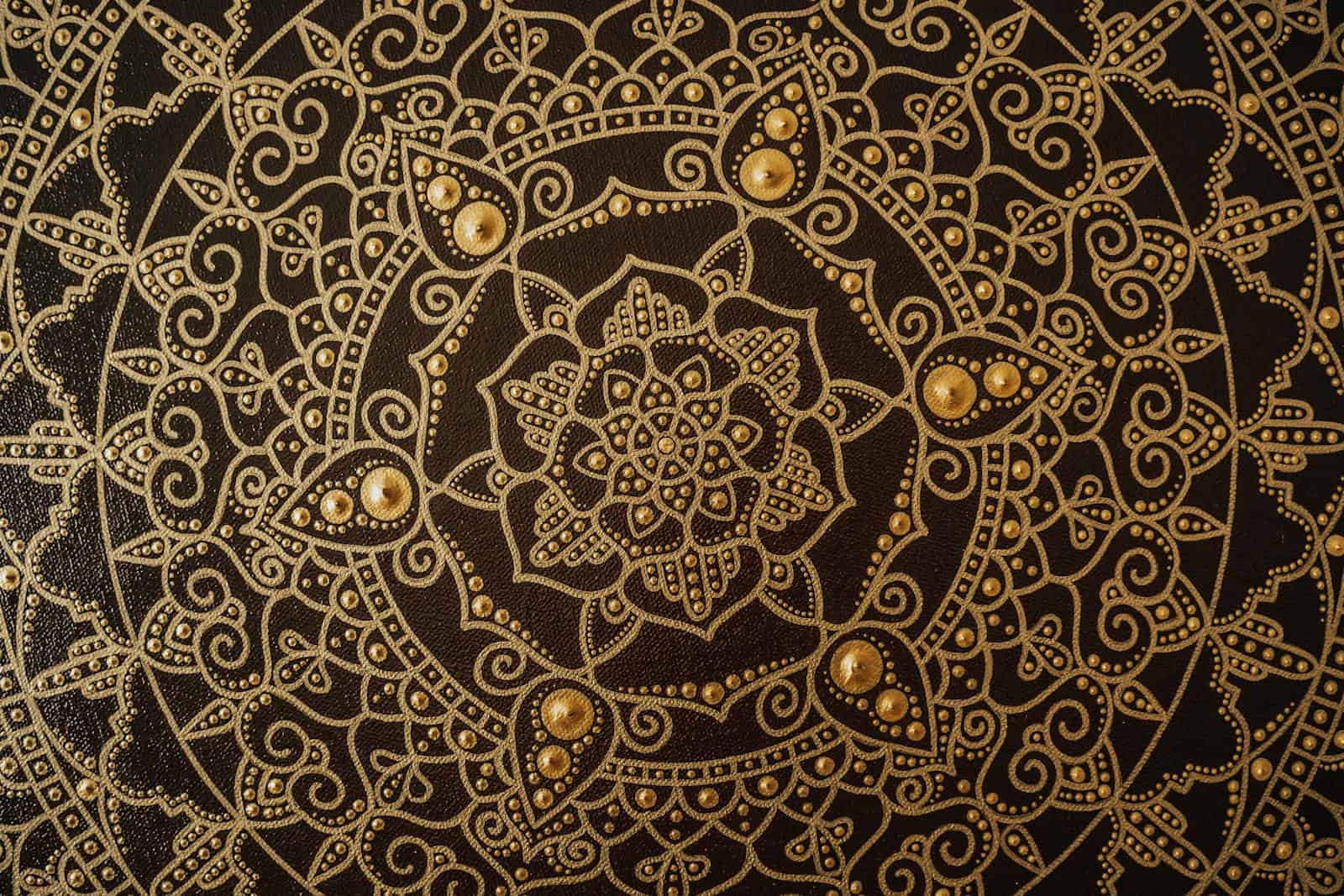The earliest known mandalas can be traced back to ancient civilizations such as the Indus Valley civilization in present-day Pakistan and India, where circular patterns were found on pottery and seals dating back to 2500 BCE. These early mandalas were believed to represent the cyclical nature of life and the universe.
Mandalas also played a significant role in ancient Buddhist and Hindu cultures. In Buddhism, mandalas were used as a visual aid for meditation and as a means to attain enlightenment. The intricate designs of Buddhist mandalas symbolize the universe and its various realms, with each element representing a different aspect of existence.
In Hinduism, mandalas were used as a tool for worship and meditation. They were often created as temporary structures during religious festivals or rituals, with each element representing a deity or aspect of divinity. These mandalas were believed to be sacred spaces where devotees could connect with the divine.
The Symbolism and Meaning Behind Ancient Mandalas
Ancient mandalas are rich in symbolism, with each element representing a deeper meaning or concept. The circle itself is a universal symbol of wholeness, unity, and infinity. It represents the cyclical nature of life, death, and rebirth, as well as the interconnectedness of all things.
Other common symbols found in ancient mandalas include the lotus flower, which represents purity and spiritual enlightenment; the sun, which symbolizes life, energy, and vitality; and the moon, which represents the feminine energy and the subconscious mind.
The colors used in mandalas also hold symbolic meaning. For example, red represents passion and energy, while blue represents calmness and spirituality. Yellow symbolizes wisdom and intellect, while green represents growth and harmony.
The Spiritual and Religious Significance of Mandalas in Ancient Times
Mandalas held great spiritual and religious significance in ancient times. They were used as a means to connect with the divine and attain higher states of consciousness. In Buddhism, mandalas were used as a visual aid for meditation, with each element representing a different aspect of enlightenment. By focusing on the intricate details of the mandala, practitioners were able to quiet their minds and enter a state of deep meditation.
In Hinduism, mandalas were used as a tool for worship and devotion. They were often created as temporary structures during religious festivals or rituals, with each element representing a deity or aspect of divinity. Devotees would meditate or chant mantras while gazing at the mandala, seeking to connect with the divine energy it represented.
The Different Types of Mandalas Found in Ancient Art and Architecture
There are several different types of mandalas found in ancient art and architecture. The most common type is the concentric circle mandala, where various geometric shapes are arranged in concentric circles. This type of mandala is often used as a tool for meditation and spiritual growth.
Another type of mandala is the square mandala, where geometric shapes are arranged in a square grid pattern. This type of mandala is often used in architecture and temple design, with each element representing a different aspect of the divine.
The third type of mandala is the radial mandala, where geometric shapes radiate outwards from a central point. This type of mandala is often used in textile design and pottery, with each element representing a different aspect of nature or the cosmos.
The Role of Mandalas in Ancient Rituals and Ceremonies
Mandalas played a significant role in ancient rituals and ceremonies. They were often created as temporary structures during religious festivals or rituals, with each element representing a deity or aspect of divinity. These mandalas were believed to be sacred spaces where devotees could connect with the divine and seek blessings.
In Buddhist rituals, mandalas were used as a means to attain enlightenment. Monks would spend hours meticulously creating intricate sand mandalas, only to destroy them once they were completed. This act symbolized the impermanence of life and the transient nature of existence.
In Hindu rituals, mandalas were used as a tool for worship and devotion. Devotees would create temporary mandalas using colored powders or flowers, with each element representing a different deity or aspect of divinity. These mandalas were believed to attract positive energy and blessings from the divine.
The Importance of Mandalas in Ancient Healing and Meditation Practices

Mandalas have long been used in ancient healing and meditation practices. The intricate designs of mandalas help to focus the mind and quiet the thoughts, making them an ideal tool for meditation. By gazing at the mandala and focusing on its intricate details, practitioners are able to enter a state of deep relaxation and inner peace.
In ancient healing practices, mandalas were used as a means to restore balance and harmony to the body, mind, and spirit. The colors and symbols used in mandalas were believed to have healing properties, with each element representing a different aspect of well-being.
The Evolution of Mandalas in Ancient Eastern and Western Traditions
Mandalas have evolved differently in different Eastern and Western traditions. In Eastern traditions such as Buddhism and Hinduism, mandalas have remained largely unchanged over the centuries. They continue to be used as a tool for meditation, spiritual growth, and worship.
In Western traditions, mandalas have gained popularity in recent years as a tool for self-expression and personal growth. Many people create their own mandalas as a form of art therapy, using the process of creating and coloring mandalas as a means to relax and reduce stress.
The Use of Mandalas in Ancient Textiles, Pottery, and Jewelry
Mandalas were often incorporated into ancient textiles, pottery, and jewelry. In textiles, mandalas were used as decorative motifs, with each element representing a different aspect of nature or the cosmos. These intricate designs were often created using various weaving or embroidery techniques.
In pottery, mandalas were often painted or carved onto the surface of the vessel. These designs were believed to bring blessings and positive energy to the user. In jewelry, mandalas were often used as pendants or amulets, with each element representing a different aspect of protection or spiritual growth.
The Influence of Ancient Mandalas on Modern Art and Design
Ancient mandalas have had a profound influence on modern art and design. Many artists and designers draw inspiration from the intricate patterns and symbolism found in ancient mandalas. They incorporate these elements into their work, creating contemporary pieces that pay homage to the rich history and cultural significance of mandalas.
In modern art, mandalas are often used as a means to explore themes of spirituality, identity, and interconnectedness. Artists create intricate mandala designs using various mediums such as paint, ink, or digital software. These contemporary mandalas often incorporate modern symbols and imagery, reflecting the changing times.
In design, mandalas are often used as decorative motifs in various products such as textiles, home decor, and accessories. The intricate patterns and vibrant colors of mandalas add a touch of beauty and spirituality to everyday objects, making them popular among consumers.
The Preservation and Revival of Ancient Mandalas in Contemporary Culture
Ancient mandalas are being preserved and revived in contemporary culture through various means. Museums and cultural institutions around the world are working to preserve and showcase ancient mandalas, ensuring that future generations can appreciate their beauty and cultural significance.
In addition, many people are incorporating mandalas into their daily lives as a means to promote mindfulness and well-being. They create their own mandalas as a form of art therapy or use coloring books that feature intricate mandala designs. These practices help to reduce stress, increase focus, and promote a sense of inner peace.
Mandalas have held deep spiritual and cultural significance in ancient cultures for centuries. They have been used as a tool for meditation, healing, and spiritual growth. The intricate designs and symbolism found in ancient mandalas reflect the beliefs and values of the people who created them.
Today, mandalas continue to be important in modern times. They have influenced modern art and design, with many artists and designers drawing inspiration from their intricate patterns and symbolism. Mandalas are also being used in contemporary practices such as art therapy and mindfulness meditation, helping people to find inner peace and balance in their lives.
As we continue to explore the rich history and cultural significance of mandalas, we can gain a deeper understanding of ourselves and our place in the universe. By incorporating these sacred designs into our daily lives, we can find solace, inspiration, and a sense of connection to something greater than ourselves.
If you’re fascinated by the intricate beauty and spiritual significance of Ancient Mandalas, you won’t want to miss this insightful article on the Astrology SA website. In their June 2023 newsletter, they delve into the profound symbolism and historical origins of these sacred geometric patterns. Discover how Mandalas have been used for meditation, healing, and self-reflection throughout the ages. To deepen your understanding of this ancient art form, check out the article here: https://astrologysa.co.za/june-2023-newsletter/.




